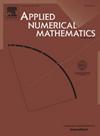Numerical simulation of a dynamic human capital model with demographic delays via the local discrete Galerkin method
IF 2.4
2区 数学
Q1 MATHEMATICS, APPLIED
引用次数: 0
Abstract
A strong and dynamic economy depends on various factors, with human capital playing a crucial role in fostering resilience and adaptability in an ever-changing world. Human capital, which depends on the past behavior of the system, requires strategic investments in education, health, and skill development. This study presents a numerical approach for solving the human capital model with age-structured delays, formulated as integro-differential equations with double delays and difference kernels. The proposed method employs a local meshless discrete Galerkin approach based on the moving least squares (MLS) technique, which can work with irregular or non-uniform data. The localized nature of the MLS scheme enhances computational efficiency by focusing on small neighborhoods. Moreover, the stabilized MLS framework, achieved by using shifted and scaled polynomial basis functions, enhances numerical stability and reduces sensitivity to the distribution of nodes, thereby transferring these advantageous properties to the method. The simplicity of the proposed algorithm makes it easy to implement on standard personal computers and extend to a wider class of delay integro-differential equations. To assess its reliability, we analyzed its error and determined the convergence order of the presented method. We have applied it to solve several numerical examples, and the obtained results confirm the method's accuracy, stability, and alignment with theoretical findings.
基于局部离散伽辽金方法的人口统计学时滞动态人力资本模型数值模拟
一个强大而充满活力的经济取决于各种因素,而人力资本在培养适应不断变化的世界的韧性和适应性方面发挥着至关重要的作用。人力资本取决于系统过去的行为,需要在教育、卫生和技能发展方面进行战略投资。本文提出了一种求解具有年龄结构延迟的人力资本模型的数值方法,该模型被表述为具有双延迟和差分核的积分-微分方程。该方法采用基于移动最小二乘(MLS)技术的局部无网格离散伽辽金方法,可以处理不规则或非均匀数据。MLS方案的局部特性通过关注小邻域来提高计算效率。此外,通过使用移位和缩放的多项式基函数实现的稳定MLS框架提高了数值稳定性,降低了对节点分布的敏感性,从而将这些优点转移到该方法中。该算法的简单性使其易于在标准个人计算机上实现,并扩展到更广泛的延迟积分微分方程。为了评估其可靠性,我们分析了该方法的误差,并确定了该方法的收敛顺序。应用该方法对若干数值算例进行了求解,得到的结果证实了该方法的准确性、稳定性以及与理论结果的一致性。
本文章由计算机程序翻译,如有差异,请以英文原文为准。
求助全文
约1分钟内获得全文
求助全文
来源期刊

Applied Numerical Mathematics
数学-应用数学
CiteScore
5.60
自引率
7.10%
发文量
225
审稿时长
7.2 months
期刊介绍:
The purpose of the journal is to provide a forum for the publication of high quality research and tutorial papers in computational mathematics. In addition to the traditional issues and problems in numerical analysis, the journal also publishes papers describing relevant applications in such fields as physics, fluid dynamics, engineering and other branches of applied science with a computational mathematics component. The journal strives to be flexible in the type of papers it publishes and their format. Equally desirable are:
(i) Full papers, which should be complete and relatively self-contained original contributions with an introduction that can be understood by the broad computational mathematics community. Both rigorous and heuristic styles are acceptable. Of particular interest are papers about new areas of research, in which other than strictly mathematical arguments may be important in establishing a basis for further developments.
(ii) Tutorial review papers, covering some of the important issues in Numerical Mathematics, Scientific Computing and their Applications. The journal will occasionally publish contributions which are larger than the usual format for regular papers.
(iii) Short notes, which present specific new results and techniques in a brief communication.
 求助内容:
求助内容: 应助结果提醒方式:
应助结果提醒方式:


